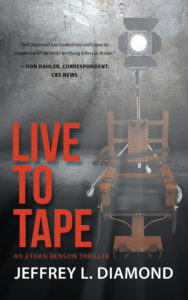Creating a Nightmare
 How do you write about a psychopath? How do you create a stone-cold killer? How do you conceptualize the demons that drive his or her personality? Many of my friends and readers have asked me these questions, curious to know how the inner workings of my mind dream up the dastardly crimes that are committed in all of my Ethan Benson thrillers. Well, for me as an author, the gangsters, hit men, sex perverts, sadists, killers and sundry ne’er-do-wells are all drawn directly from the stories I worked on as a writer, director, and producer at ABC News 20/20 and Dateline NBC. Case in point: the dastardly killer, Dr. Rufus Wellington, in my second novel, Live to Tape. Dr. Wellington is a sadistic pervert who maimed and murdered a young lady of the night who he picked up on the streets of a notorious Boston combat zone. As a character, he is incarcerated in Walpole State Prison, where he is serving a life sentence. In each of Wellington’s scenes, he is wheeled into a highly secure interview room, draped in handcuffs and manacles, and then chained to a chair. There are correction officers scattered about the room, hovering over him, toting long guns, guarding him as if their lives depended on it.
How do you write about a psychopath? How do you create a stone-cold killer? How do you conceptualize the demons that drive his or her personality? Many of my friends and readers have asked me these questions, curious to know how the inner workings of my mind dream up the dastardly crimes that are committed in all of my Ethan Benson thrillers. Well, for me as an author, the gangsters, hit men, sex perverts, sadists, killers and sundry ne’er-do-wells are all drawn directly from the stories I worked on as a writer, director, and producer at ABC News 20/20 and Dateline NBC. Case in point: the dastardly killer, Dr. Rufus Wellington, in my second novel, Live to Tape. Dr. Wellington is a sadistic pervert who maimed and murdered a young lady of the night who he picked up on the streets of a notorious Boston combat zone. As a character, he is incarcerated in Walpole State Prison, where he is serving a life sentence. In each of Wellington’s scenes, he is wheeled into a highly secure interview room, draped in handcuffs and manacles, and then chained to a chair. There are correction officers scattered about the room, hovering over him, toting long guns, guarding him as if their lives depended on it.
Setting aside the specifics of his crime—I don’t want to give away my story—Rufus Wellington is an explosive personality with a cigarette constantly dangling from his mouth, his eyes staring fixedly into the distance, his facial expressions sinister, angry, cruel, taunting. He constantly rocks back and forth against his restraints, curses profusely, and threatens anybody and everybody who crosses his path—especially my hero, Ethan Benson, and his mercurial anchorman, Peter Sampson. He is truly evil incarnate, a devil, a monster, a nightmare—a character without a conscience or the slightest semblance of civility.
So how did I dream him up?
And who did I come across as a TV journalist who serves as the blueprint for his personality and his crimes?
Meet Henry Lee Lucas, one of the most notorious and prolific serial killers in American history, who I interviewed with a full production team for a segment that aired on 20/20 in the mid-1980s. Lucas was truly frightening as a human being. He was a small, slight man, mostly quiet and serene on the outside, and like my character, a wild man on the inside ready to erupt like a volcano on a moment’s notice. On the day we conducted our interview in a small rural jail in Texas, where Lucas was being held between court appearances for one of the hundred or so murders he committed, he too was draped in chains, his feet manacled, his arms strapped to a chair, his head immobile in a harness. There were half-a-dozen Texas Rangers guarding him, toting long guns, all pacing nervously around a secure conference room as we set up our cameras. There was a moment that I remember vividly, when I found myself all alone with Lucas pulling cables for my cameraman, his steely eyes boring into me, my nerves frayed, my emotions all over the place—until one of the Texas Rangers who was sitting in a chair just outside the room, quietly pointed his rifle at Lucas, and said without an ounce of emotion in his voice, “I’ll blow your head off, motherfucker, if you move even a muscle.” The experience was so unnerving that when I got a back to my room after finishing the interview, I took a long hot shower to wash off any remnants of Lucas that may have clung to my body during the course of the interview.
I have never forgotten that experience.
The sheer terror still lives deep inside me.
So when developing my killer and writing his dialogue in Live to Tape, Henry Lee Lucas was the model I used from my other life as a journalist to give birth to my character. I tried to capture the nuances of his personality, his penchant for wild and disruptive behavior, and the cold and calculating way he described the unimaginable things he had done to his victims. So Dr. Rufus Wellington is the killer in my novel. And Henry Lee Lucas is the demon in my dreams.